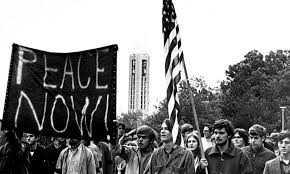In 1969, the United States was deeply embroiled in the Vietnam War, a conflict that had sparked widespread opposition and resistance among the American public. The anti-Vietnam War demonstrations that took place during this tumultuous year were a powerful expression of dissent, activism, and solidarity against a war that had divided the nation and fueled a growing sense of disillusionment and unrest. The Vietnam War, which had been escalating since the early 1960s, had become increasingly unpopular among many Americans who questioned the rationale, morality, and costs of the conflict. As the war dragged on and casualties mounted, opposition to the war grew, fueled by images of violence, destruction, and suffering that were broadcast into living rooms across the country. In 1969, anti-war sentiment reached a fever pitch as protests, demonstrations, and acts of civil disobedience swept across the nation. One of the most iconic anti-Vietnam War demonstrations of 1969 was the Moratorium to End the War in Vietnam, a nationwide day of protest and activism that took place on October 15. Organized by a coalition of anti-war groups, the Moratorium brought together millions of Americans in cities and towns across the country to call for an immediate end to the war and a withdrawal of U.S. troops from Vietnam. The Moratorium included peaceful marches, rallies, teach-ins, and other forms of nonviolent protest, drawing attention to the human costs and moral implications of the war. The Moratorium to End the War in Vietnam was a pivotal moment in the anti-war movement, as it showcased the breadth and depth of opposition to the conflict and demonstrated the power of grassroots activism in shaping public opinion and influencing government policy. The Moratorium brought together people from all walks of life – students, teachers, veterans, clergy, and ordinary citizens – who shared a common commitment to ending the war and building a more just and peaceful world. In addition to the Moratorium, 1969 saw a wave of anti-Vietnam War demonstrations on college campuses, in communities, and at military bases across the country. Students, faculty, and activists organized rallies, sit-ins, and marches to protest the war and demand an immediate withdrawal of U.S. troops from Vietnam. These demonstrations were often met with resistance and violence from authorities, leading to clashes and arrests that further fueled public outrage and galvanized the anti-war movement. One of the most infamous anti-Vietnam War demonstrations of 1969 was the May 4th Kent State shootings, where National Guard troops opened fire on unarmed student protesters at Kent State University in Ohio, killing four students and wounding nine others. The tragic events at Kent State shocked the nation and brought renewed attention to the anti-war movement, highlighting the high stakes and risks involved in speaking out against the war. Overall, the anti-Vietnam War demonstrations of 1969 were a defining moment in American history, as they showcased the power of grassroots activism, civil disobedience, and peaceful protest in challenging government policies and advocating for social change. The demonstrations of 1969 helped to shift public opinion on the war, mobilize a new generation of activists, and inspire a broader movement for peace, justice, and human rights. The legacy of the anti-Vietnam War demonstrations of 1969 continues to resonate today as a reminder of the importance of dissent, solidarity, and civic engagement in shaping a more just and peaceful world.
5 April 1994 U.S.A. Kurt Cobain
